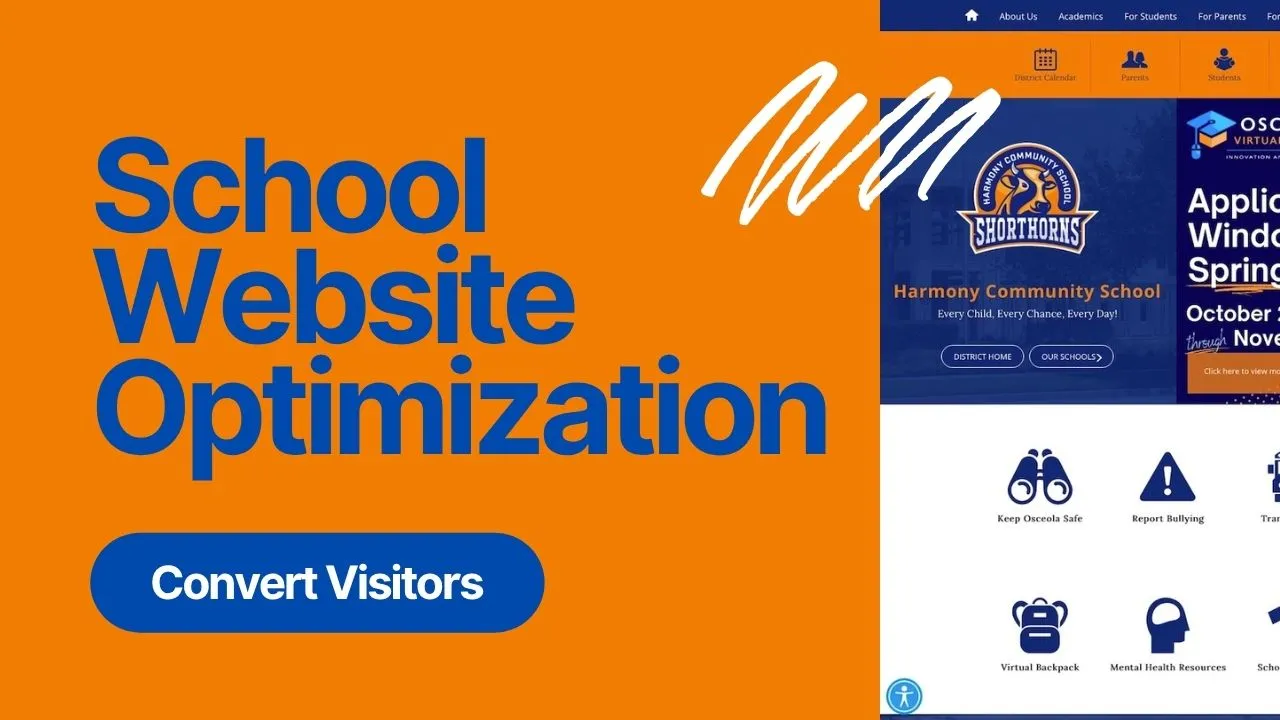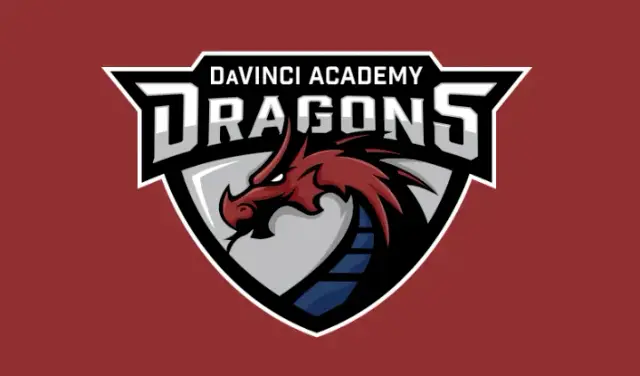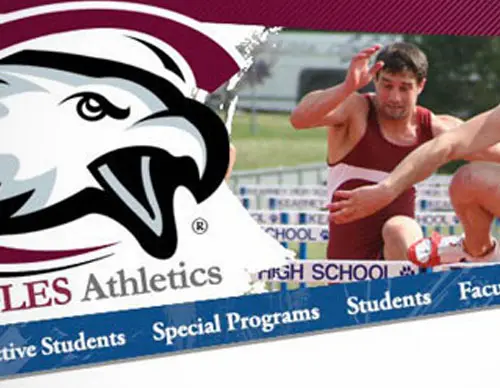School Branding Blog
School Website Optimization: Convert Visitors to Enrolled Families (2025)

Your school website is often the first impression families have of your institution, yet most school websites fail to convert visitors into enrolled students. With 73% of parents researching schools online before making enrollment decisions, optimizing your website for conversion is critical for enrollment success.
The School Website Conversion Challenge
The Problem: Most school websites are designed for information delivery, not enrollment conversion.
The Opportunity: Schools that optimize their websites for conversion see 40-60% increases in enrollment inquiries.
The Solution: Implement these 10 proven strategies to transform your website into an enrollment powerhouse.
This challenge is compounded when schools don’t understand how branding influences parent choice or how to create effective messaging that converts prospects into enrolled families.
Strategy 1: Optimize Your Homepage for First Impressions
The 7-Second Rule
Parents form opinions about your school within 7 seconds of landing on your homepage. Your homepage must immediately communicate:
- What makes your school unique
- Your core value proposition
- Clear next steps for interested families
Homepage Optimization Checklist
Above the Fold (First Screen):
- Compelling headline that differentiates your school
- Clear value proposition in 10 words or less
- High-quality hero image showing engaged students
- Prominent “Schedule a Tour” or “Learn More” button
- Social proof (testimonials, awards, recognition)
Example: Henderson Collegiate’s website immediately communicates academic excellence and college preparation through strategic messaging and visual design.
Schools with Strong Digital Presence

St. Cloud Middle School | School Branding Agency
Client: St. Cloud Middle School Location: St. Cloud, Florida Project: Mustang Mascot & School Identity School Type: Middle School School District: Osceola County School District

Woodbridge School District Mascot Logo & Branding
Woodbridge, DE

DaVinci Academy Mascot Logo | School Branding Agency
Client: DaVinci Academy Location: Ogden, Utah Project: Dragon Mascot & Brand Identity System
Strategy 2: Create Compelling About Pages That Build Trust
The Trust-Building Formula
Parents need to trust your school before they’ll enroll their children. Your About page should include:
Leadership Credentials:
- Principal’s background and educational philosophy
- Administrative team qualifications
- Board of directors or advisory board information
School History and Mission:
- Compelling origin story
- Clear mission and vision statements
- Core values and educational philosophy
- Notable achievements and milestones
Community Connection:
- Local partnerships and community involvement
- Alumni success stories
- Parent and student testimonials
Strategy 3: Optimize Academic Program Pages
Showcase Your Educational Excellence
Academic program pages are crucial for enrollment decisions. Optimize them with:
Program Highlights:
- Specific curriculum details and benefits
- Student achievement data and outcomes
- Unique programs and specializations
- College and career preparation information
Visual Evidence:
- Photos of students engaged in learning
- Classroom environments and facilities
- Student work samples and projects
- Teacher qualifications and expertise
Success Metrics:
- Graduation rates and college acceptance
- Standardized test scores and improvements
- Student awards and recognition
- Alumni achievements and career paths
Strategy 4: Implement Strategic Call-to-Action Placement
The CTA Optimization Framework
Every page should guide visitors toward enrollment actions:
Primary CTAs (High Priority):
- “Schedule a Campus Tour”
- “Request Information Packet”
- “Apply for Enrollment”
- “Contact Admissions”
Secondary CTAs (Support Actions):
- “Download School Guide”
- “View Virtual Tour”
- “Meet Our Teachers”
- “See Student Work”
CTA Best Practices:
- Use action-oriented language
- Create urgency with limited-time offers
- Make buttons visually prominent
- Test different CTA placements and wording
Strategy 5: Leverage Social Proof and Testimonials
The Power of Parent and Student Voices
Social proof is one of the most powerful conversion tools:
Testimonial Types:
- Parent testimonials - Focus on outcomes and satisfaction
- Student testimonials - Highlight engagement and growth
- Alumni testimonials - Emphasize long-term success
- Teacher testimonials - Showcase expertise and passion
Testimonial Placement:
- Homepage hero section
- Academic program pages
- About page
- Dedicated testimonials page
- Enrollment process pages
Example: St. Cloud Middle School’s website features parent testimonials that highlight the school’s impact on student growth and community engagement.
Strategy 6: Optimize for Mobile Experience
The Mobile-First Reality
67% of parents research schools on mobile devices. Your website must be:
Mobile-Optimized Features:
- Fast loading times (under 3 seconds)
- Touch-friendly navigation and buttons
- Readable text without zooming
- Easy-to-use contact forms
- Quick access to key information
Mobile-Specific Content:
- Simplified navigation menus
- Condensed information for small screens
- Mobile-friendly forms and applications
- Quick contact options (click-to-call, text)
Strategy 7: Create Compelling Virtual Tour Experiences
The Virtual Campus Visit
Virtual tours have become essential for enrollment:
Virtual Tour Components:
- 360-degree classroom views
- Interactive campus maps
- Video walkthroughs of key facilities
- Student and teacher interviews
- Program-specific virtual experiences
Virtual Tour Best Practices:
- Keep tours under 5 minutes
- Include multiple tour options (academic, athletic, arts)
- Provide guided and self-guided options
- Include interactive elements and hotspots
- Make tours easily shareable
Strategy 8: Implement Enrollment-Focused Content Strategy
Content That Converts
Create content specifically designed to move families through the enrollment funnel:
Awareness Stage Content:
- “What to Look for in a School” guides
- “School Choice Decision Factors” articles
- “Understanding School Rankings” resources
Consideration Stage Content:
- “Why Choose Our School” comparison guides
- “Academic Program Deep Dives” articles
- “Student Success Stories” case studies
Decision Stage Content:
- “Enrollment Process Guide” step-by-step instructions
- “Financial Aid and Scholarships” information
- “New Student Orientation” resources
Strategy 9: Optimize Contact and Inquiry Forms
The Form Conversion Formula
Contact forms are critical conversion points:
Form Optimization:
- Keep forms short (3-5 fields maximum)
- Use progressive profiling for longer forms
- Include clear value propositions
- Provide multiple contact options
- Test different form layouts and copy
Form Fields That Work:
- Name and email (essential)
- Phone number (for follow-up)
- Student grade level (for personalization)
- Specific interests or concerns (for customization)
- Preferred contact method (for optimization)
More School Branding Success Stories

Jepson Jaguars School Brand Identity
Cordele, Georgia

Republic School District Logo Design
Client: Republic R-III School District Location: Republic, Missouri Project: District-Wide Brand Architecture

Chadron State College Mascot Logo
Chadron State College believes that sports and athletics offer desirable personal development and recreation for participants, and a healthy focus for collegiate constituencies. The CSC athletic program participates ful…
Strategy 10: Implement Conversion Tracking and Analytics
Data-Driven Optimization
Track what’s working and what isn’t:
Key Metrics to Monitor:
- Website traffic and visitor behavior
- Contact form completion rates
- Tour request conversion rates
- Enrollment inquiry sources
- Page engagement and time on site
Analytics Tools:
- Google Analytics for traffic analysis
- Google Tag Manager for conversion tracking
- Heat mapping tools for user behavior
- A/B testing platforms for optimization
Case Study: Website Optimization Success
Before Optimization:
- 2.1% contact form conversion rate
- 1,200 monthly website visitors
- 25 monthly enrollment inquiries
After Optimization:
- 6.8% contact form conversion rate (224% increase)
- 1,800 monthly website visitors (50% increase)
- 122 monthly enrollment inquiries (388% increase)
Key Changes Made:
- Redesigned homepage with clear value proposition
- Added compelling testimonials and social proof
- Optimized contact forms and CTAs
- Implemented mobile-first design
- Created virtual tour experience
Implementation Timeline
Week 1-2: Foundation
- Audit current website performance
- Identify conversion bottlenecks
- Set up analytics and tracking
Week 3-4: Content Optimization
- Rewrite key pages for conversion
- Add testimonials and social proof
- Optimize contact forms
Week 5-6: Technical Improvements
- Implement mobile optimization
- Improve page loading speeds
- Add conversion tracking
Week 7-8: Testing and Refinement
- A/B test key elements
- Monitor conversion metrics
- Refine based on data
Measuring Success
Conversion Metrics:
- Contact form completion rate
- Tour request conversion rate
- Enrollment inquiry quality
- Website engagement metrics
Enrollment Metrics:
- Inquiry-to-enrollment conversion
- Enrollment source attribution
- Parent satisfaction scores
- Student retention rates
Related Resources
- Digital-First School Branding Strategy: Complete digital guide
- School Branding That Drives Enrollment Growth: Strategic implementation
- How School Branding Influences Parent Choice: Psychology behind decisions
Ready to optimize your school website for enrollment conversion? Get your custom website assessment and discover how strategic improvements can transform your enrollment results.
We Build and Manufacture Mascot Costumes
A professionally built mascot costume creates unforgettable moments at games, rallies, and community events.

See Full Details →
Design to Delivery
We manage everything
6-12 Week Delivery
In time for your season
Safety First
Ventilation & visibility
Starts at $2,500
Professional quality
About Mash Bonigala
Mash Bonigala is the Founder & CEO of School Branding Agency. Over the past 15 years, he's helped 250+ K-12 schools transform their brand identity and drive enrollment growth. From charter schools to public districts, Mash specializes in creating mascot systems and brand strategies that rally communities, boost school spirit, and convert prospects into enrolled families. Schedule a Zoom call to discuss your school →
Mascot logo design
Get an enrollment-ready mascot your community loves
Start with our mascot logo design service. We’ll craft a distinctive, on‑brand mascot system and rollout plan tailored for your school.
Start your estimateRelated
Charter Application Branding - Professional Identity for Authorizer Approval
Professional charter application branding that demonstrates operational readiness to authorizers. Complete brand identity, website, and application materials. Charter-specific packages from $8K.
View detailsRelated
Charter School Branding - Mascots & Identity (2025)
We help charter schools build mascots and identity systems that rally communities and support enrollment. See packages and proof.
View details
